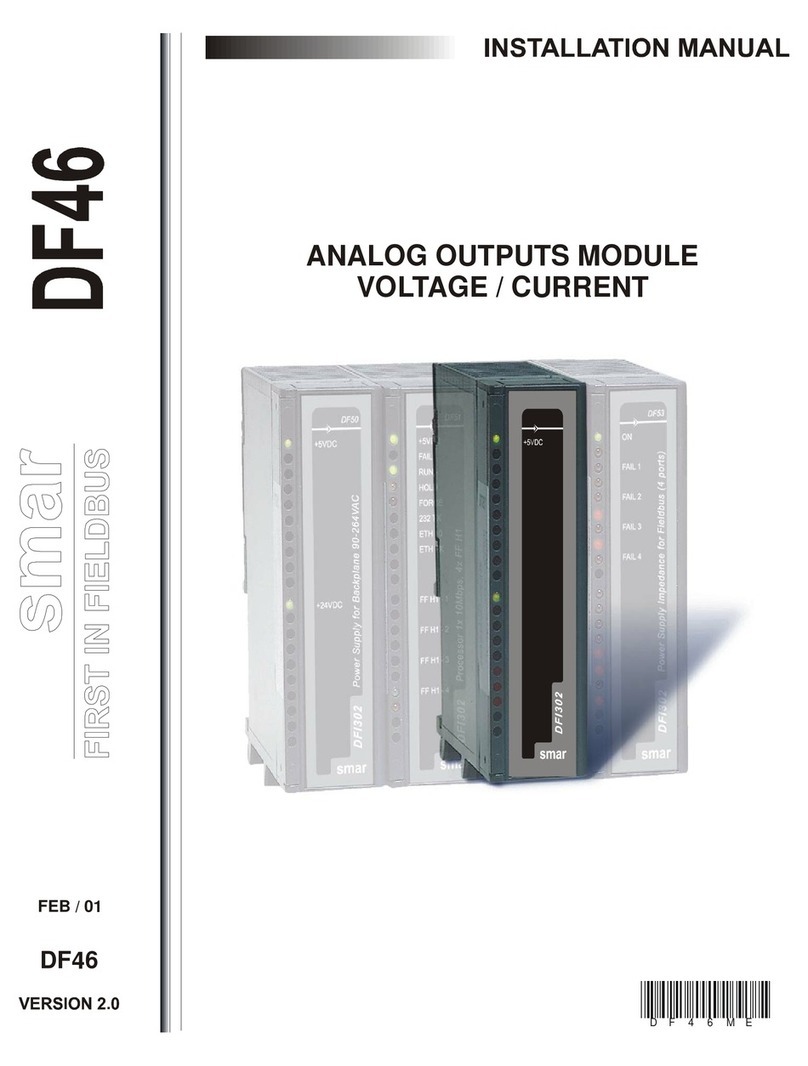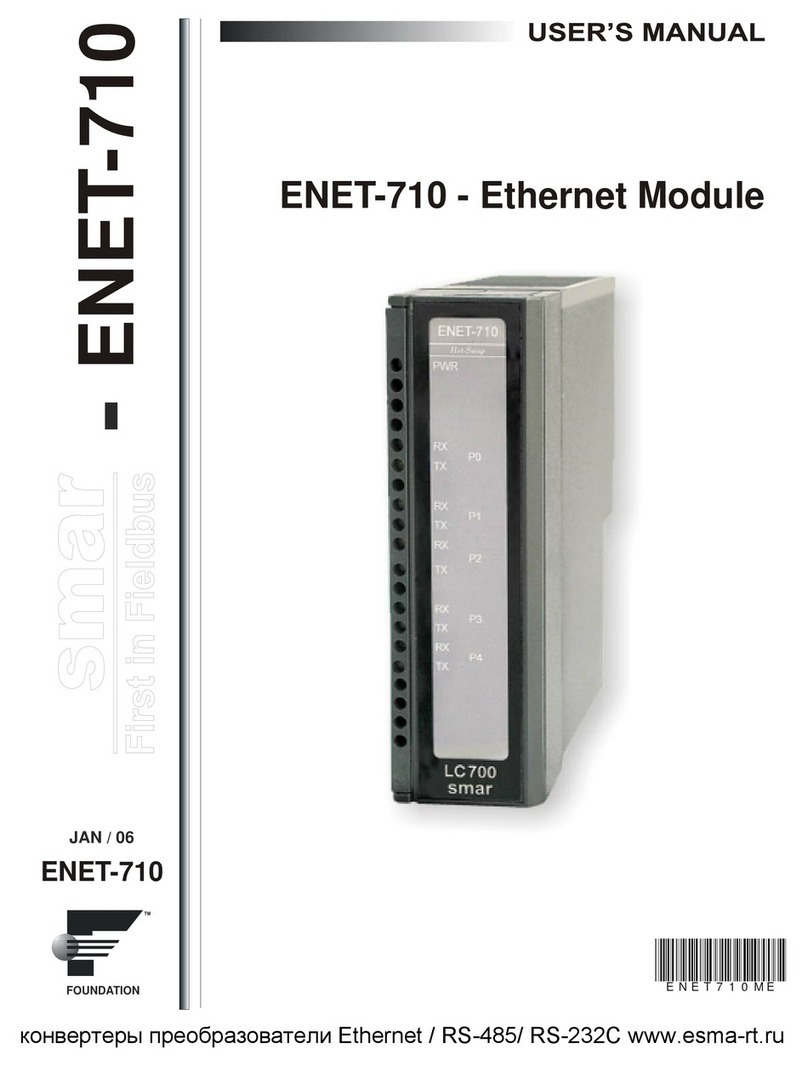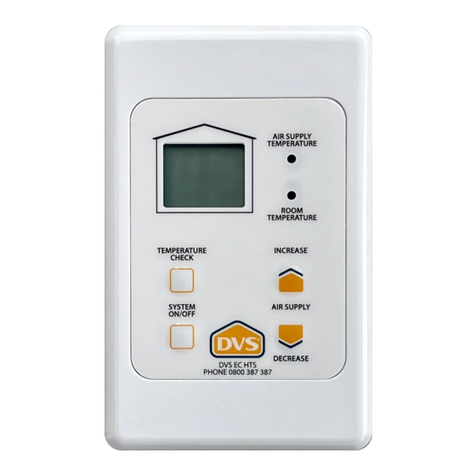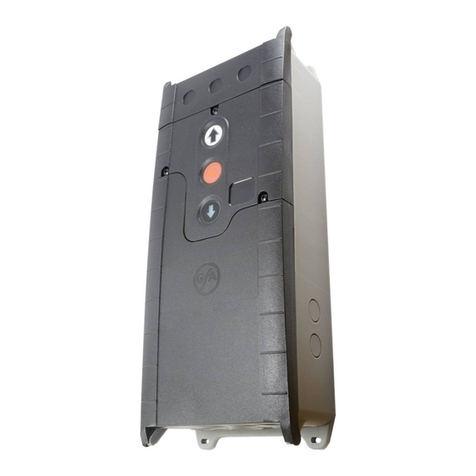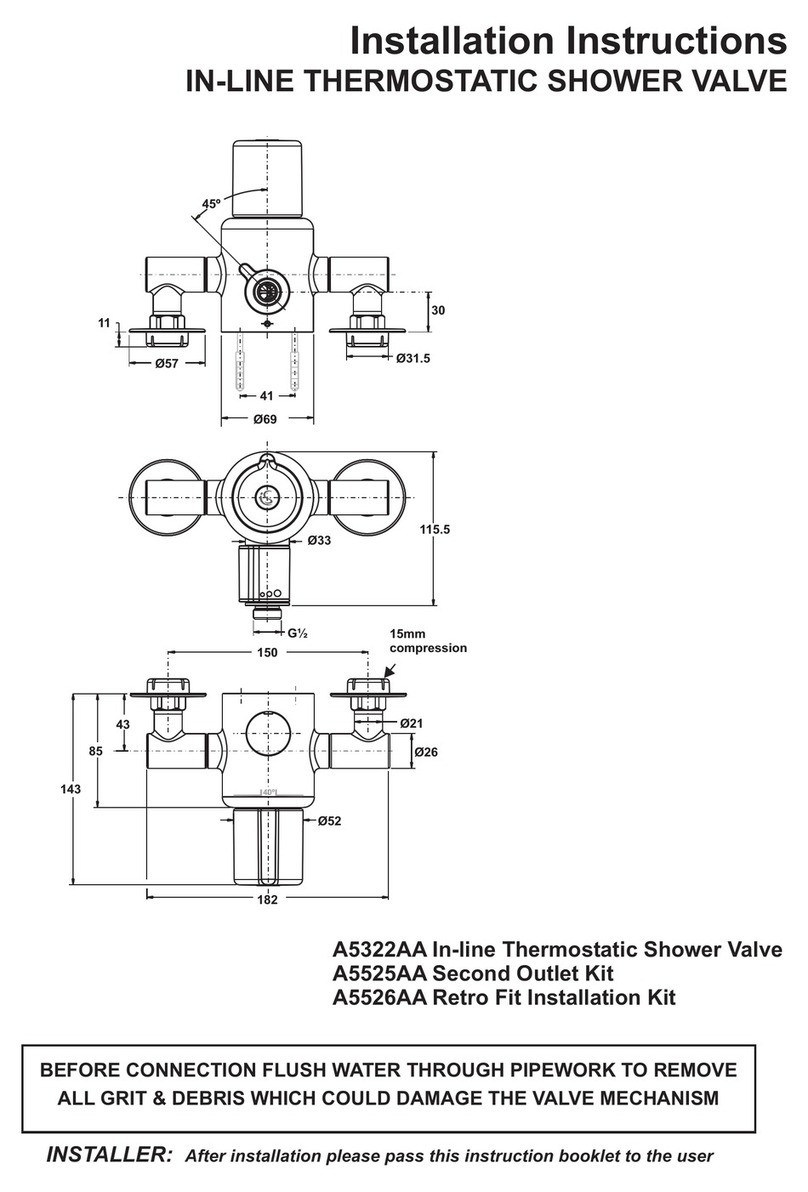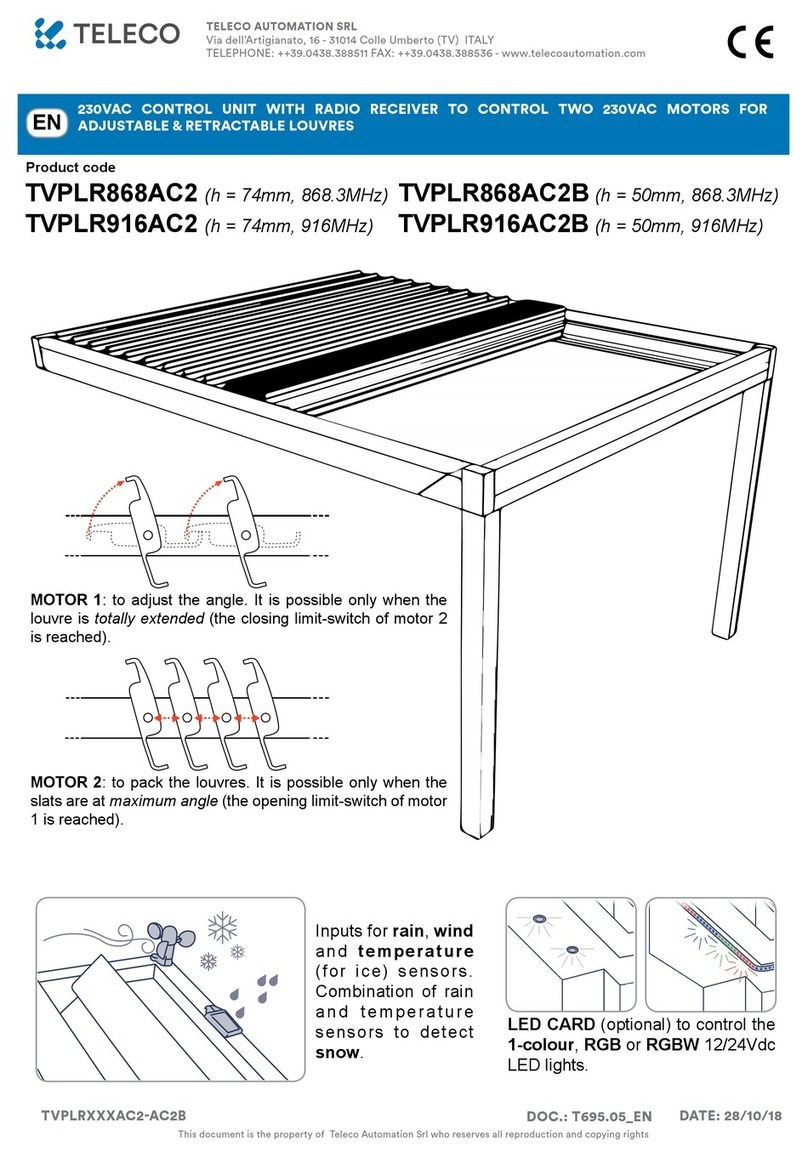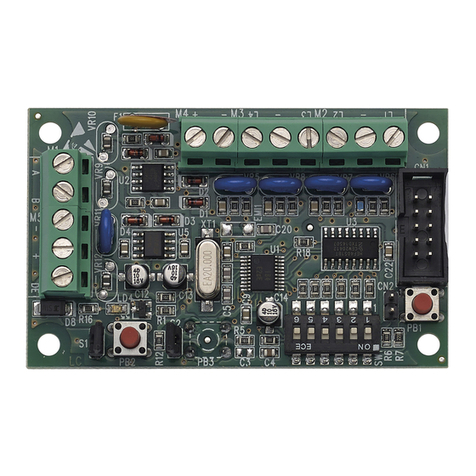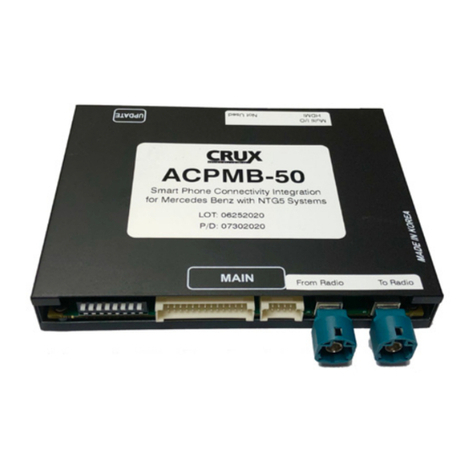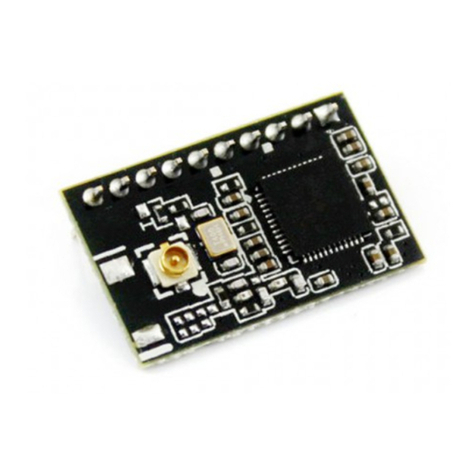SMAR FY302 Manual

FY302ME
MAR / 05

web: www.smar.com
smar
Specifications and information are subject to change without notice.
For the latest updates, please visit the SMAR website above.
BRAZIL
Smar Equipamentos Ind. Ltda.
Rua Dr. Antonio Furlan Jr., 1028
Sertãozinho SP 14170-480
Tel.: +55 16 3946-3510
Fax: +55 16 3946-3554
e-mail: insales@smar.com.br
CHINA
Smar China Corp.
3 Baishiqiao Road, Suite 30233
Beijing 100873, P.R.C.
Tel.: +86 10 6849-8643
Fax: +86-10-6894-0898
FRANCE
Smar France S. A. R. L.
42, rue du Pavé des Gardes
F-92370 Chaville
Tel.: +33 1 41 15-0220
Fax: +33 1 41 15-0219
e-mail: smar.am@wanadoo.fr
NETHERLANDS
Smar Nederland
De Oude Wereld 116
2408TM Alphen aan den Rijn
Tel: +31 172 494 922
Fax: +31 172 479 888
e -mail : info@smarnederland.nl
GERMANY
Smar GmbH
Rheingaustrasse 9
55545 Bad Kreuznach
Germany
Tel: + 49 671-794680
Fax: + 49 671-7946829
MEXICO
Smar Mexico
Cerro de las Campanas #3 desp 119
Col. San Andrés Atenco
Tlalnepantla Edo. Del Méx - C.P. 54040
Tel.: +53 78 46 00 al 02
Fax: +53 78 46 03
SINGAPORE
SmarSingapore Pte. Ltd.
315 Outram Road
#06-07, Tan Boon Liat Building
Singapore 169074
Tel.: +65 6324-0182
Fax: +65 6324-0183
e-mail: info@smar.com.sg
UNITED KINGDOM
SmarUK Ltd
3, Overhill Road - Cirencester
Gloucestershire -
GL7 2LG
Tel: +44 (0)797 0094138
Fax: +44 (0)797 4747502
e-mail: info@smarUK.co.uk
USA
Smar International Corporation
6001 Stonington Street, Suite 100
Houston, TX 77040
Tel.: +1 713 849-2021
Fax: +1 713 849-2022
e-mail: sales@smar.com
Smar Laboratories Corporation
6001 Stonington Street, Suite 100
Houston, TX 77040
Tel.: +1 713 849-2021
Fax: +1 713 849-2022
e-mail: sales@smar.com
Smar Research Corporation
4250 Veterans Memorial Hwy. Suite 156
Holbrook , NY 11741
Tel: +1-631-737-3111
Fax: +1-631-737-3892
e-mail: sales@smarresearch.com

Introduction
III
INTRODUCTION
The FY302 is a Fieldbus valve positioner for Single (spring return) or Double acting Linear motion
type control valves e. g. Globe, Gate, Diaphragm, Pinch or Clamp and Rotary motion type control
valves e. g. Ball, Butterfly or Plug with pneumatic type actuators e. g. Diaphragm, Piston, Vane, or
Bellows. It is based on a field-proven piezo flapper and non-contacting Hall-effect position sensor
that provides reliable operation and high performance. The digital technology used in the FY302
enabled the choice of several types of flow characterizations, an easy interface between the field
and the control room and several interesting features that considerably reduce the installation,
operating and maintenance costs.
The FY302 is part of Smar's complete 302 line of Fieldbus devices.
Fieldbus is not only a replacement for 4-20 mA, or intelligent/smart transmitter protocols, it contains
much more. Fieldbus is a complete system enabling distribution of the control function to equipment
in the field.
Some of the advantages of bi-directional digital communications are known from existing smart
transmitter protocols: Higher accuracy, multi-variable access, remote configuration and diagnostics,
and multi-dropping of several devices on a single pair of wires.
The main requirements for Fieldbus were to overcome these problems. Closed loop control with
performance like a 4-20 mA system requires higher speed. Since higher speed means higher power
consumption, this clashes with the need for intrinsic safety. Therefore a moderately high
communication speed was selected, and the system was designed to have a minimum of
communication overhead. Using scheduling the system controls variable sampling, algorithm
execution and communication so as to optimize the usage of the network, not loosing time. Thus,
high closed loop performance is achieved.
Using Fieldbus technology, with its capability to interconnect several devices, very large control
schemes can be constructed. In order to be user friendly the function block concept was introduced
(users of SMAR CD600 should be familiar with this, since it was implemented there years ago). The
user may now easily build and overview complex control strategies. Another advantage is added
flexibility; the control strategy may be edited without having to rewire or change any hardware.
The FY302, like the rest of the 302 family, has several Function Blocks built in, like PID controller,
Input Selector and Splitter/Output Selector, eliminating the need for separate device. This takes to
reduced communication and thereby less dead-time and tighter control, not to mention the reduction
in cost.
The need for implementation of Fieldbus in small as well as large systems was considered when
developing the entire 302 line of Fieldbus devices. They have the common features of being able to
act as a master on the network and be configured locally using a magnetic tool, eliminating the need
for a configurator or console in many basic applications.
Get the best result of the FY302 by carefully reading these instructions.
WARNING
Throughout the operation of the positioner, including self-setup, do not touch the moving parts of
valve/actuator/positioner assembly as they may unexpectedly move automatically. Make sure to
disconnect supply air before touching any moving parts.

FY302 – Operation, Maintenance and Instructions Manual
IV
NOTE
This manual is compatible with version 3XX, where 3 denotes software version and XX software
release. The indication 3.XX means that this manual is compatible with any release of software
version 3.

Table of Contents
V
TABLE OF CONTENTS
SECTION 1 - INSTALLATION.................................................................................................1.1
GENERAL..............................................................................................................................1.1
MOUNTING............................................................................................................................1.1
ROTARY MOVEMENT..............................................................................................................1.1
LINEAR MOVEMENT ...............................................................................................................1.2
PNEUMATIC CONNECTIONS....................................................................................................1.2
ELECTRONIC HOUSING ROTATING..........................................................................................1.5
ELECTRIC WIRING .................................................................................................................1.5
TOPOLOGY AND NETWORK CONFIGURATION...........................................................................1.6
INTRINSIC SAFETY BARRIER...................................................................................................1.8
JUMPER CONFIGURATION ......................................................................................................1.8
POWER SUPPLY ....................................................................................................................1.8
RECOMMENDATIONS FOR AN INSTRUMENT AIR SYSTEM...........................................................1.8
SECTION 2 - OPERATION......................................................................................................2.1
FUNCTIONAL DESCRIPTION -OUTPUT MODULE.......................................................................2.1
FUNCTIONAL DESCRIPTION-ELECTRONICS..............................................................................2.2
INTRODUCTION TO FIELDBUS APPLICATION .............................................................................2.4
FUNCTION BLOCKS................................................................................................................2.4
TRANSDUCER BLOCKS...........................................................................................................2.4
RESOURCE BLOCK ................................................................................................................2.4
THE LOCAL INDICATOR ..........................................................................................................2.5
FOUR DIFFERENT POSITIONS TO THE LCD DISPLAY................................................................2.6
SECTION 3 - CONFIGURATION.............................................................................................3.1
TRANSDUCER BLOCK.............................................................................................................3.1
TRANSDUCER BLOCK DIAGRAM..............................................................................................3.1
FIELDBUS POSITIONER TRANSDUCER .....................................................................................3.2
TRANSDUCER BLOCK PARAMETER DESCRIPTION ....................................................................3.7
TRANSDUCER BLOCK PARAMETER ATTRIBUTES......................................................................3.9
HOW TO CONFIGURE A TRANSDUCER BLOCK........................................................................3.11
AUTO-SETUP ......................................................................................................................3.11
CALIBRATION ......................................................................................................................3.13
POSITION TRIM....................................................................................................................3.14
Via SYSCON....................................................................................................................................3.14
SENSOR PRESSURE ............................................................................................................3.18
FLOW CHARACTERIZATION...................................................................................................3.19
TEMPERATURE CALIBRATION ...............................................................................................3.21
DISPLAY TRANSDUCER BLOCK.............................................................................................3.21
DEFINITION OF PARAMETERS AND VALUES............................................................................3.22
CALIBRATING VIA LOCAL ADJUSTMENT.................................................................................3.24
PROGRAMMING USING LOCAL ADJUSTMENT .........................................................................3.25
SECTION 4 - MAINTENANCE PROCEDURES ......................................................................4.1
GENERAL..............................................................................................................................4.1
DISASSEMBLY PROCEDURE ...................................................................................................4.2
REASSEMBLY PROCEDURE ....................................................................................................4.3
SECTION 5 - TECHNICAL CHARACTERISTICS...................................................................5.1
FUNCTIONAL SPECIFICATIONS................................................................................................5.1
PERFORMANCE SPECIFICATIONS............................................................................................5.2
PHYSICAL SPECIFICATIONS....................................................................................................5.2
SMAR -GENERAL TERMS OF WARRANTY ..............................................................................5.5

FY302 – Operation, Maintenance and Instructions Manual
VI

Section 1
1.1
INSTALLATION
General The overall accuracy of measurement and control depends on several variables. Although the
converter has an outstanding performance, proper installation is essential, in order to maximize its
performance.
Among all factors, which may affect converter accuracy environmental conditions are the most
difficult to control. There are, however, ways to reduce the effects of temperature, humidity and
vibration.
The FY302 has a built-in temperature sensor to compensate for temperature variations. At the field,
this feature minimizes the temperature variation effect.
Locating the positioner in areas protected from extreme environmental changes can minimize
temperature fluctuation effects.
In warm environments, the positioner should be installed to avoid, as much as possible, direct
exposure to the sun. Installation close to lines and vessels subjected to high temperatures should
also be avoided.
Use of sunshades or heat shields to protect the positioner from external heat sources should be
considered, if necessary.
Humidity is fatal to electronic circuits. In areas subjected to high relative humidity, the O-rings for the
electronics cover must be correctly placed. Removal of the electronics cover in the field should be
reduced to the minimum necessary, since each time it is removed; the circuits are exposed to
humidity. The electronic circuit is protected by a humidity proof coating, but frequent exposures to
humidity may affect the provided protection. It is also important to keep the covers tightened in
place. Every time they are removed, the threads are exposed to corrosion, since painting cannot
protect these parts. Code approved sealing methods on conduit entering the positioner should be
employed.
Although the positioner is virtually insensitive to vibration, installation close to pumps, turbines or
other vibrating equipment should be avoided.
Mounting The mounting of positioner FY302 will depend on actuator type, single (spring return) action or
double action and on actuator movement, if it is linear or rotary. Two supports are required for
mounting, one for the magnet and the other for the positoner itself. Smar may supply them both
since they are specified in the order code. (See Table 5.2 – Bracket Ordering Code).
Rotary Movement
Install the magnet on the valve stem using the magnet support (See Figure 1.2 - Positioner on
Rotary Actuator).
Install the positioner support on the actuator. The actuator should be in accordance with standard
VDI/VDE 5845, all you have to do is tighten the four screws with the lock washers on the standard
support.
For special supports, refer to specify instructions. After installing the support on the actuator, it is
possible to mount the positioner FY302 on the support by means of the four screws with lock
washers.
Make sure that the arrow engraved on the magnet coincides with the arrow engraved on the
positioner when the valve is in mid travel.
If the installation of the positioner or magnet should be altered, or if there should be any other
modification, the positioner will require a recalibration.
As to the type of valve action, refer to paragraph "Pneumatic Connections".

FY302 – Operation, Maintenance and Instructions Manual
1.2
Linear Movement
Install the magnet on the valve stem using the magnet support (See Figure 1.3 - Positioner on
Linear Actuator).
Install the positioner support on the actuator. The actuator support may be secured in place as per
standard NAMUR/IEC 536-4 or in accordance with user specified boring. Install the positioner on the
support and tighten the four screws in the threaded bores located on the side opposite to the
pressure gages (See Figure 1.3 - Positioner on Linear Actuator). Use lock washers in order to
prevent screw slackening.
Make sure that the support is not obstructing the exhaustion outlets.
NOTE
Make sure that arrow engraved on the magnet coincides with the arrow engraved on the positioner when the
valve is in mid travel. The magnet mounting in relation to the hall sensor:
1 . Must not have attrict between the internal magnet face and the hall sensor salience during the travel
(rotary or linear), through the magnet.
2. The magnet and the salience of hall sensor must not be distant.
A minimum distance of 2mm and a maximum distance of 4mm is recommended between the magnet external
face and the positioner face. For that, a centralizer device (linear or rotary) must be used. The centralizer
device is in the positioner packing.
If the installation of the positioner or magnet should be altered, or if there should be any other
modification, the positioner will require a recalibration.
Pneumatic Connections
Air supplied to the positioner FY302 shall be quality instrument air, i. e., dry, clean and non-
corrosive. Refer to the American National Standard. “Quality Standard for Instrument Air” (ANSI/ISA
S7.0.01 - 1996).
The FY302 is supplied with input and outputs air filters; but these filters do not substitute a
preliminary instrumentation air treatment. We recommend a periodic cleaning of such filters each 6
months or less, case the air instrument quality is not good.
Air supply pressure to the FY302 shall be between 1.4 bar (20 psi) and 7 bar (100 psi). In case such
requirements can not be fulfilled, the use of an air pressure regulator is acceptable.
Use sealant on threads. Sealants like PTFE (Teflon) tape shall be avoided because they may
fragment and eventually obstruct internal parts.
The positioner FY302 may be supplied with pressure gages. There are taps available for IN, OUT1
and OUT2. Before connecting the pressure gages, make sure that all lines be completely purged.
Valve positioner FY302 has two pneumatic outputs. They work on opposite directions to open or
close the valve.
WARNING
The FY302 should fail, for example, because of a power failure. The output identified as OUT1 (output 1)
goes to nearly zero; while the output identified as OUT2 (output 2) goes to nearly the air supply pressure.
Pneumatic connections are identified as IN (input) for the air supply, and OUT1 and OUT2 for
Output 1 and Output 2 respectively (See Figure 1.1 - FY302 Dimensional Drawing). Use 1/4 NPT
connections. Sealant may be used NPT threads. Connect the air supply tubing to the connection
identified as IN. Make sure that the air supply pressure does not exceed the maximum rating
accepted by the positioner or actuator. The tubing used to connect the positioner FY302 to the
actuator shall be as short as possible. The manometer supply is optional.
NOTE
When ordering the positioner in stainless steel 316, combined with the local pressure gauges, the gauge
case is in SS 316. For wet parts and threads in SS 316, please, consult Smar.
ATTENTION
Make sure that sealant does not enter the positioner.

Installation
1.3
There are six exhaust outputs in the FY302, all of them fitted with filters (See Figure 1.1 - FY302
Dimensional Drawing).
It is very important that such outputs are neither blocked nor obstructed, because the air must
circulate freely.
All filters shall be inspected to make sure they will not obstruct the outputs (Refer to Section 4 -
Maintenance Procedures).
Double Action - Air to Open (Fail Close)
Connect Output 1 (OUT1) of the positioner to the input identified as OPEN in the actuator, and
connect Output 2 (OUT2) of the positioner to the input CLOSE in the actuator (See Figure 1.1 -
FY302 Dimensional Drawing).
Double Action - Air to Close (Fail Open)
Connect Output 2 (OUT2) of the positoner to the input identified as OPEN in the actuator, and
connect Output 1 (OUT 1) of the positioner to the input CLOSE of the actuator.
Single Action
Connect Output 1 (OUT1) of the positioner to the input of the actuator. Use a plug to block Output 2
(OUT2). (The Figure 1.2 - Positioner on Rotary Actuator and Figure 1.3 - Positioner on Linear
Actuator show the positioner in rotary and linear actuators).
OUTPUT 1
1/8 - 27 NPT
55
4
6
,5
69
21
24
50
(
1,97
)
(0,954)
(0,83)
(2,72)
24
(0,94)
113
(4,45)
(1,83)
83
39 45 45 260
83
33
22,5
HOLE 6,3 (0,25)
(2 PLACES)
10
A
(0,59)
(0,89)
(1,30)
(2,10)
53,3
49,5 56
(2,17)
(1,95)
24 24
EXHAUST ORIFICIES
(0,94) (0,94)
(1,54) (1,77)
6,5
MOUNTING ROLES FOR M6x1
SCREWS (2 PLACES)
Up to 15 mm (0,59)
TRAVEL DIMENSION A
Up to 50 mm (1,97)
43 mm (1,7)
105 mm (4,13)
181 mm (7,12)
Up to 100 mm (3,94)
(0,25)
22 22
39
(
1,54
)
(0,87) (0,87)
(1,77) (10,24)
(3,27)
OUTPUT 1
1’/4 - 18NPT OUTPUT 2
1’/4 - 18NPT
(2,16)
(3,27)
64,5
18
(2,54)
(0,71)
AIR SUPPLY
1/8 - 27 NPT
AIR
SUPPLY
1/8 - 27 NPT
OUTPUT 2
1/8 - 27 NPT
VALVE POSITIONER
ROTARY MAGNET
LINEAR MAGNET
A
ll dimensions are in mm
(
in
)
Up to 30 mm (1,18) 67 mm (2,64)
Figure 1.1 - FY302 Dimensional Drawing

FY302 – Operation, Maintenance and Instructions Manual
1.4
ROTATING
MAGNET BASE
ROTARY
MAGNET
POSITIONER
BASE
POSITIONER
VALVE STEM
Figure 1.2 - Positioner on Rotary Actuator
LINEAR MAGNET
BRACKET
VALVE YOKE
VALVE STEM
LINEAR MAGNET
CENTRALIZER
DEVICE
POSITIONER
POSITIONER
BRACKET
Figure 1.3 - Positioner on Linear Actuator

Installation
1.5
Electronic Housing Rotating
The electronic housing can be rotated in order to have a better position of the digital display. To
rotate it, use the Housing Rotation Set Screw. (See Figure 1.4 – Cover Locking and Housing
Rotation Set Screw).
The local indicator itself can also be rotated. (See Figure 2.4 – Rotating the position of the LCD
Display).
Electric Wiring
Reach the wiring block by removing the Electrical Connection Cover. This cover can be locked by
the cover locking screw. To release the cover, rotate the locking screw clockwise.
The wiring block has screws on which fork or ring-type terminals can be fastened.
(See Figure 1.5 – Wiring Block).
Figure 1.4 - Cover Locking and Housing Rotation Set Screw
or convenience there are two ground terminals: one inside the cover and one external, located
Figure 1.5 - Wiring Block
HOUSING ROTATION
SET SCREW
COVER
LOCKING
SCREW
F
close to the conduit entries. (See Figure 1.5 – Wiring Block).
GROUND
TERMINA
L
POWER
SUPPLY
TERMINALS
COMMUNICATION
TERMINALS

FY302 – Operation, Maintenance and Instructions Manual
1.6
WARNING
In hazardous areas with explosion proof requirements, the covers must be tightened with at least 8 turns. In
order to avoid the penetration moisture or corrosive gases, tighten the O’ring until feeling the O'ring touching
the housing. Then, tighten more 1/3 turn (120°) to guarantee the sealing. Lock the covers using the locking
screw.
In hazardous zones with intrinsically safe or non incendive requirements, the circuit entity parameters and
applicable installation procedures must be observed.
Cable access to wiring connections is obtained by the two conduit outlets. Conduit threads should be sealed
by means of code-approved sealing methods. The unused outlet connection should be plugged and sealed
accordingly.
Should other certifications be necessary, refer to the certification or specific standard for installation
limitations.
The Figure 1.6 - Conduit Installation Diagram shows the correct installation of the conduit, in order
to avoid penetration of water, or other substance, which may cause malfunctioning of the
equipment.
Figure 1.6 - Conduit Installation Diagram
NOTE
Please refer to the General Installation, Operation and Maintenance Manual for more details.
Topology and Network Configuration
Bus topology (See Figure 1.7 - Bus Topology) and tree topology (See Figure 1.8 - Tree Topology)
are supported. Both types have a trunk cable with two terminations. The devices are connected to
the trunk via spurs. The spurs may be integrated in the device giving zero spur length. A spur may
connect more than one device, depending on the length. Active couplers may be used to extend
spur length.
Active repeaters may be used to extend the trunk length.
The total cable length, including spurs, between any two devices in the Fieldbus should not exceed
1900m.
The connection of couplers should be kept less than 15 per 250m.
CO
RRE
C
T
WIRES
IN
CO
RRE
C
T

Installation
1.7
Figure 1.7 - Bus Topology
Figure 1.8 - Tree Topology
PS302
FAIL
ON
smar
PSI302
FAIL
1
FA
ON
IL
FAIL
FAIL
smar
smar
0
FUSE
2,5A
PS
I3
02
3.
(P
ow
er
Su
ppl
y
Im
pe
da
n
c
1A
2A
3A
4A
IN
24VDC
BT
OUT 1
Fieldbus H1
OUT 2
Fieldbus H1
OUT 3
Fieldbus H1
OUT 4
Fieldbus H1
5A
6A
7A
8A
9A
10A
Spur
Terminator
Enabled
Spur Spur
Junction
Box
Terminator
Shield
+
++
PS302
FAIL
ON
smar
PSI302
ON
FAIL
FAIL
smar
FAIL
FAIL COUPLER
smar
FUSE
2,5A
y
Im
pe
da
PS
I3
02
3.
ppl
0
(P
ow
er
Su
nc
1A
2A
3A
IN
24VDC
OUT 1
Fieldbus H1
OUT 2
Fieldbus H1
4A
BT
OUT 3
Fieldbus H1
OUT 4
Fieldbus H1
5A
6A
7A
8A
9A
10A

FY302 – Operation, Maintenance and Instructions Manual
1.8
Intrinsic Safety Barrier
on the trunk
Jumper Configur
st be correctly
When the Fieldbus is in an area requiring intrinsic safety, a barrier must be inserted
between the power supply and the power supply end terminator.
Use of SB302 is recommended.
ation
In order to work properly, the jumpers J1 and W1 located in the FY302 main board mu
configured (See Table 1.1 - Description of the Jumpers).
J1 This jumper enables the simulation mode parameter in the AO block.
W1 This jumper enables the local adjustment programming tree.
Table 1.1 - Description of the Jumpers
The FY302 receives power from the bus via the signal wiring. The power supply ma
separate unit or from another device such as a controller or DCS.
The voltage should be between 9 to 32 Vdc for non-intrinsic safe applications.
A special requirement applies to the power supply used in an intrinsically safe bus an
the type of barrier used.
Use of PS302 is recommended as power supply.
Power Supply
y come from a
d depends on
Recommendations or an Instrum
ity, airborne
y in case of
, instrument air shall
f
ent Air System
Instrument air quality shall be superior to that of industrial compressed air. Humid
particles and oil may impair the instrument operation, either temporarily or permanentl
internal parts wearing.
As per standard ANSI/ISA S7.0.01 - 1996 - Quality Standard for Instrument Air
the following characteristics:
Dew point 10°C below minimum plant temperature
Size of particles (airborne) 3 m (maximum)
Oil content 1 ppm w/w (maximum)
Contaminants free from toxic flammable gases
Table 1.2 - Quality Standard for Instrument Air
This standard recommends that the compressor intake be located in an area free from pro
and fitted with and adequate filter. It also recommends the use of non-lubricated type c
in order to prevent air contamination by lubricating oil. Where lubricated type compr
adopted, there shall be used means to make the air oil free.
The Figure 1.9 - Air Supply System and Figure 1.10 - Air Quality Conditioning System sho
system for Air Supply and Air Quality Conditioning.
cess spills
ompressors,
essors are
w a typical

Installation
1.9
emote Hall Sensor
me vibrations applications. It prevents excessive wear of the equipment and,
onsequently, the reduction of its useful lifetime.
mote sensor’s connection cable are of low intensity. Therefore, it is
commended to install the cable inside a conduit (maximum length 20 meters) away from possible
s nduction and/or e cable supplied by Smar is shielded
in ord ite this protection, it is not
r e e conduit with other cables.
T the sensor’s c
Fig. 1.13 –Hall Sensor cable and its accessories
Figure 1.9 - Air Supply System
Figure 1.10 - Air Quality Conditioning System
R
The remote Hall magnetic sensor is recommended for applications where there are high
temperatures and extre
c
The electric signals on the re
re
ources of i
er to protect it agai
electromagnetic interferences. Th
nst electromagnetic interferences. Desp
ecommended for the cabl to share the sam
he parts for onnection cable are:
COMPRESSOR
INTAKE
RAIR RECEIVER
ITH DRAIN
COMPRE AFTERCOOLER CONDENSATE
SEPARATO
SSOR
WITH DRAIN W
OIL AND
MIST PR
WITH
WATER
EFILTER
RAIN
D
A
IR
DRYER
DRY AIR
A
FTER FILTER

FY302 – Operation, Maintenance and Instructions Manual
1.10
Disassembly Procedure
he steps for
for the
1.13 and
Figures 1.11 to 1.14 show the correct disassembling order for the Hall sensor. T
disassembling are:
Unscrew the cover, by turning it on counter-clockwise direction (direction of the arrow)
remote Hall side according to figure 1.11.
Pull the cable following the arrow as in figure 1.12,
Pull the cable connector base, to release it from the block connector, according to figures
1.14.
Fig. 1.14 – Disconnecting the cover of the Hall
sensor cable Fig. 1.15 – Disconnecting the Hall sensor cable
Fig. 1.16 –Unfastened connector Fig. 1.17 – Connector with the cable’s wires
maintained in their orifices
Fig. 1.18 – Wires position in the connector Fig. 1.19 – Release the cables’ connector
Assembly Procedure

Installation
1.11
Mount the components following the sequence:
gh the base connector orifice (Figure 1.18);
Pass the cable through the cover orifice (Figure 1.17);
Pass the cable throu
The red, white, and black wires should be inserted in the base connector orifice marked by numbers
beside them, look at Figure 1.19 e 1.20.
Fig. 1.20 – Assembling the cover Fig. 1.21 – Assembling the wire bracket
Fig. 1.22 – Inserting the wires in the connector. Fig. 1.23 – Orifice Cable’s Connector with
Numbers beside them.
Insert the cable connector in the remote Hall's block connector as figure 1.21. The block connector
has internal saliencies that perfectly fit the groove, in order to prevent errors in the assembly. The
cutting p will cut th us
establi the cable and the ha
o finish, fasten the cover to the Hall sensor’s connection (figure 1.2
ins inside of the block connector
shing the electric contact between e wire insulators and press against them, th
ll sensor’s circuit.
2).T
Fig. 1.24– Fasten the cover to the remote Hall. Fig. 1.25 –Assembly finished.

FY302 – Operation, Maintenance and Instructions Manual
1.12

Section 2
2-1
OPERATION
Functional Description - Output Module
The main parts of the output module are the pilot, servo, Hall effect sensor and the output control
circuit. (See Figure 2.1 - Pneumatic Transducer Schematic).
The control circuit receives a digital setpoint signal from the CPU and a feedback signal from the
Hall effect sensor.
The pneumatic circuit is based on a well-known and widely adopted technology, which is described
on item Nozzle-and-Vane and Spool.
PILOT
RESTRICTION
PILOT DIAPHRAGM
SPOOL DIAPHRAGM
AIR SUPPLY
NOZZLE
PIEZO
VANE
SPOOL
PILOT
CHAMBER
VENT 2
OUTPUT 2
OUTPUT 1
VENT 1
SPRING
Figure 2.1 - Pneumatic Transducer Schematic
A piezoelectric disk as flapper in the pilot stage. The flapper is deflected when the control circuit
applies a voltage. A small stream of air flowing through the nozzle is obstructed causing an increase
in pressure in the pilot chamber, this is called the pilot pressure.
The pilot pressure is too low, with flowing capacity, and for this reason it must be amplified in the
servo section. The servo section includes a diaphragm in the pilot chamber and a smaller one in the
spool chamber. The pilot pressure applies a force at the pilot chamber's diaphragm which, in the
equilibrium state, will be equal to the force applied by the spool valve at the smaller diaphragm
which is in the spool chamber.
Therefore, upon every position change caused by the positioner, the pilot pressure increases or
decreases as explained in the pilot stage section; such change in pilot pressure causes an upward
or downward valve travel wich alters the pressure at output 1 and output 2 until a new equilibrium is
reached, which results in a new valve position.

FY302 – Operation, Maintenance and Instructions Manual
2-2
Functional Description-Electronics
Refer to the block diagram (See Figure 2.2 - FY302 Block Diagram). The function of each block is
described below.
MAIN CIRCUIT BOARD DISPLAY
FIELDBUS
A
IR SUPPL
Y
(PIN)
TRANSDUCER ASSEMBLY
VALVE
P1
P2 ACTUATOR
M
A
G
N
E
T
VALVE
S
T
E
M
DISPLAY
CONTROLLE
R
SUPPLY
POWER
SUPPLY
COMMUNICATIO
N
FIELDBUS
CONTROLLE
R
EEPROM
RAM
FLASH
LOCAL
ADJUST
D/A
A/D
CPU
CONTROL
TEMPERATUR
E
SENSOR
ISOLATION
HALL
SENSOR
CIRCUIT
PIEZO
FLAPPER
NOZZLE
RESTRICTIO
N
SPOOL
VALVE
HALL
SENSOR
ANALOGIC BOARD
RECEIVER
FILTER AND
SIGNAL
SHAPING A/D
FIRMWARE
DOWNLOAD
INTERFACE
Figure 2.2 - FY302 Block Diagram
Other manuals for FY302
2
Table of contents
Other SMAR Control Unit manuals
Popular Control Unit manuals by other brands

Allen-Bradley
Allen-Bradley 1794-IE8H user manual
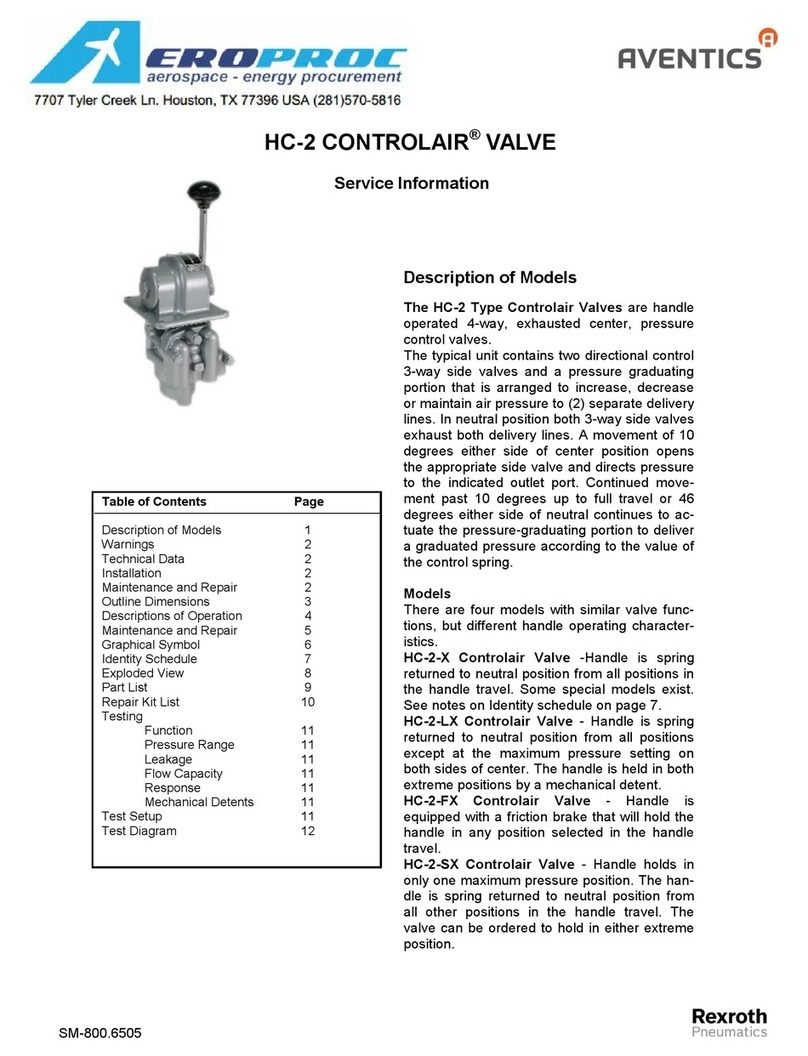
Aventics
Aventics CONTROLAIR HC-2 Series Service information
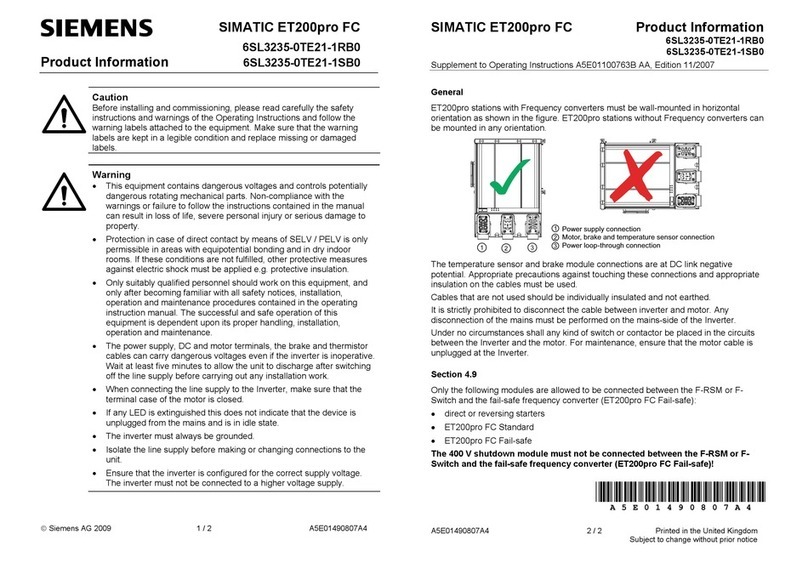
Siemens
Siemens Simatic ET200pro Product information
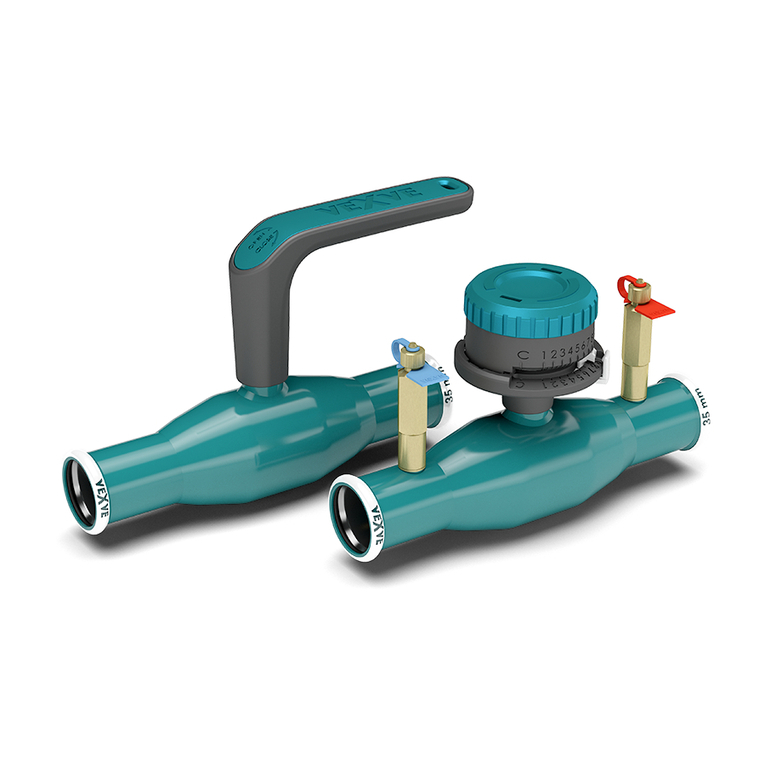
Vexve
Vexve X Series installation, operation, adjustment and maintenance manual
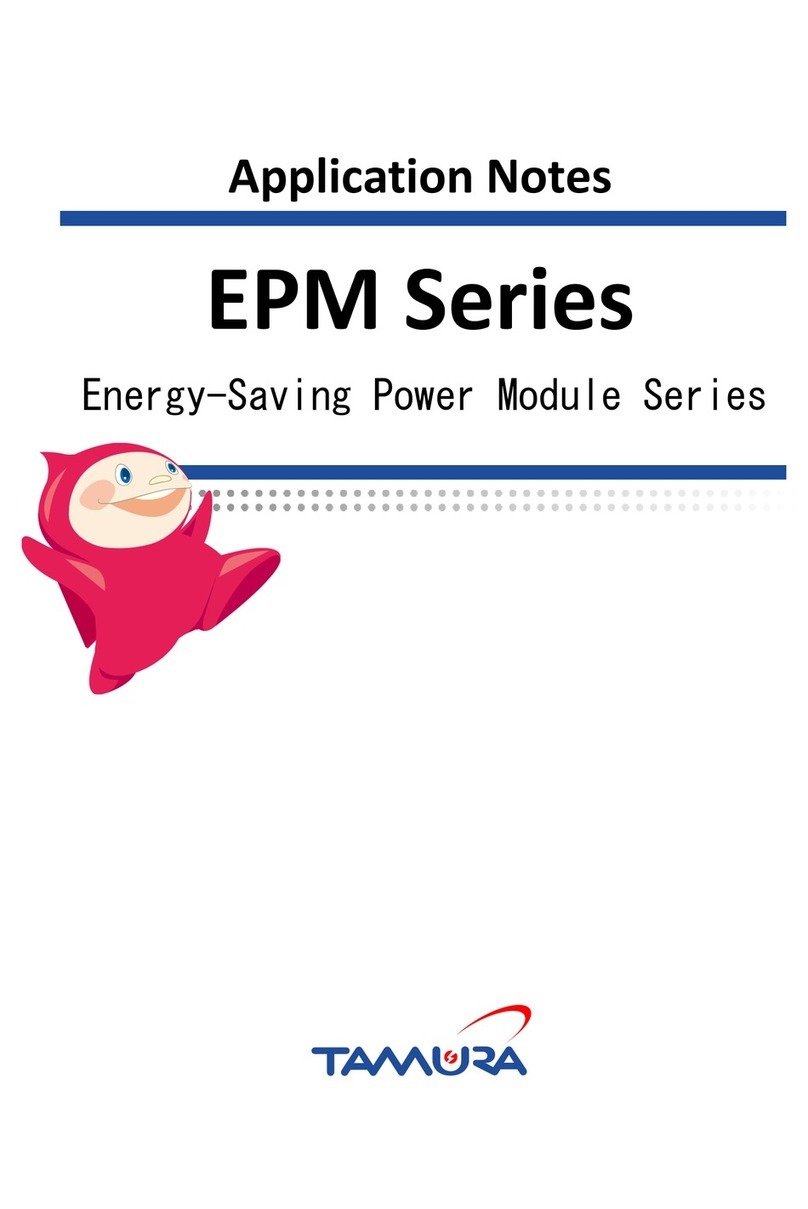
TAMURA
TAMURA EPM Series Application notes
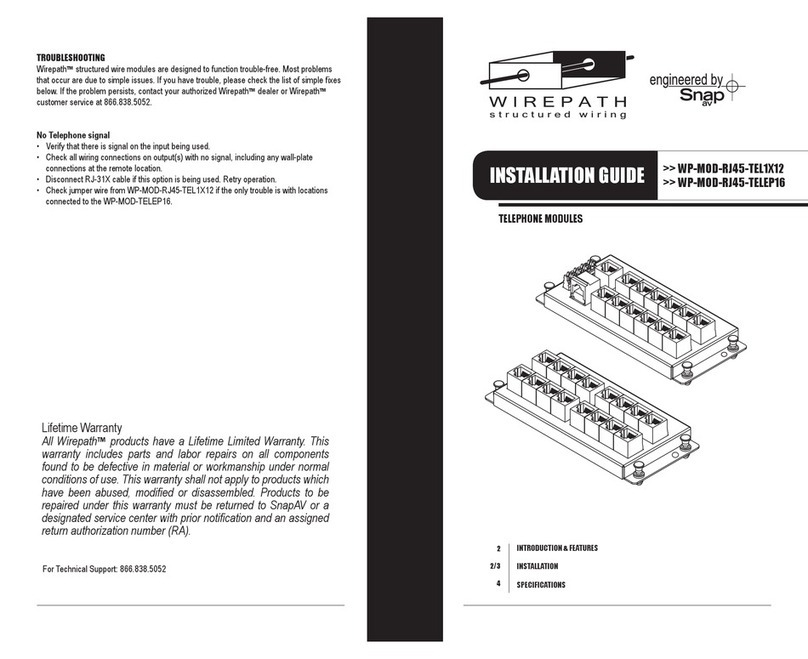
Wirepath
Wirepath WP-MOD-RJ45-TEL1X12 installation guide
